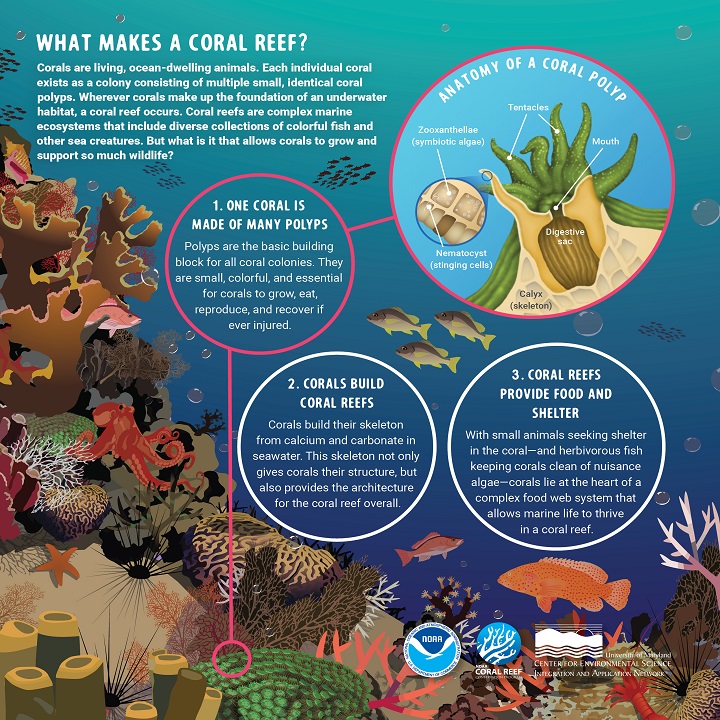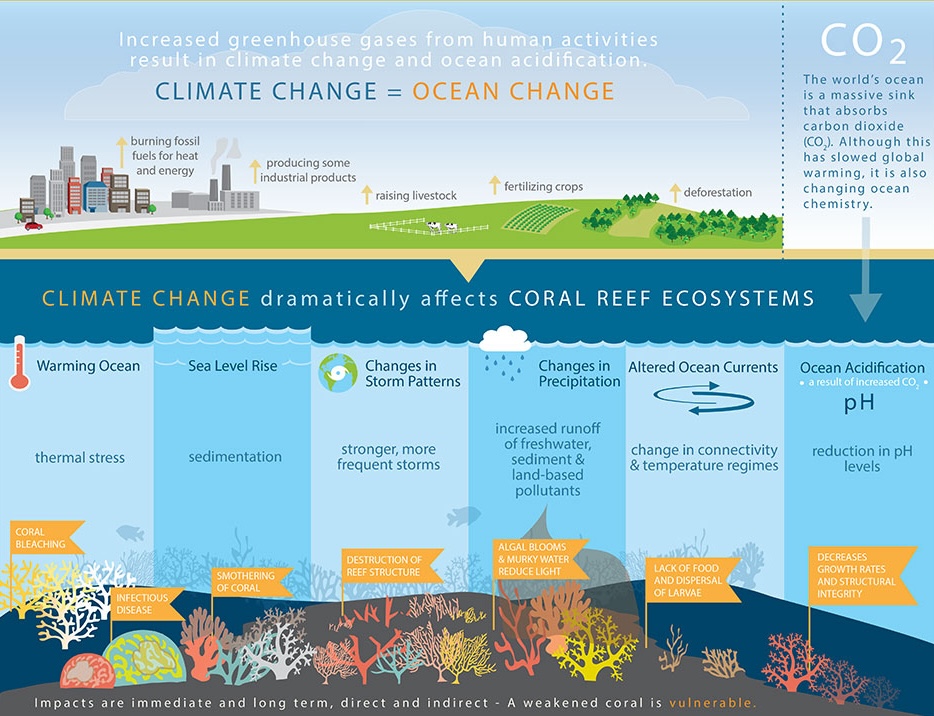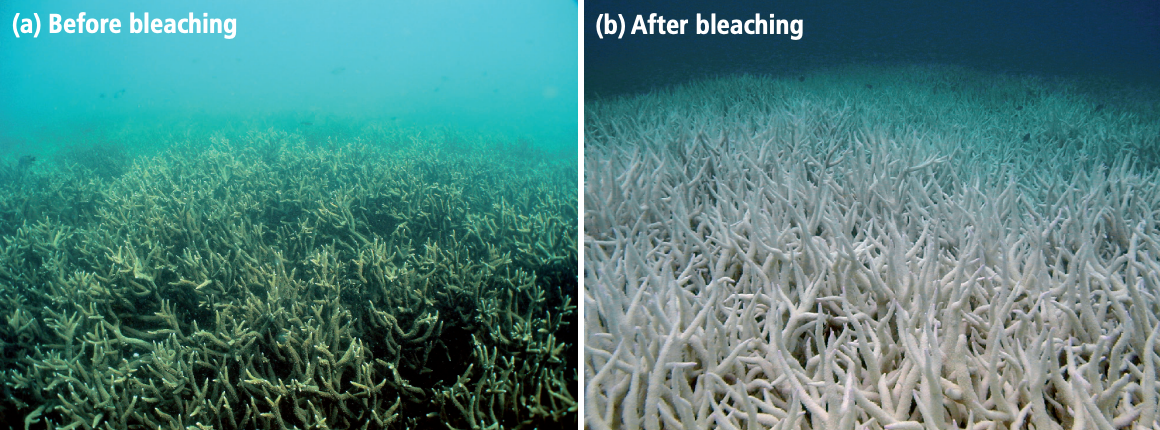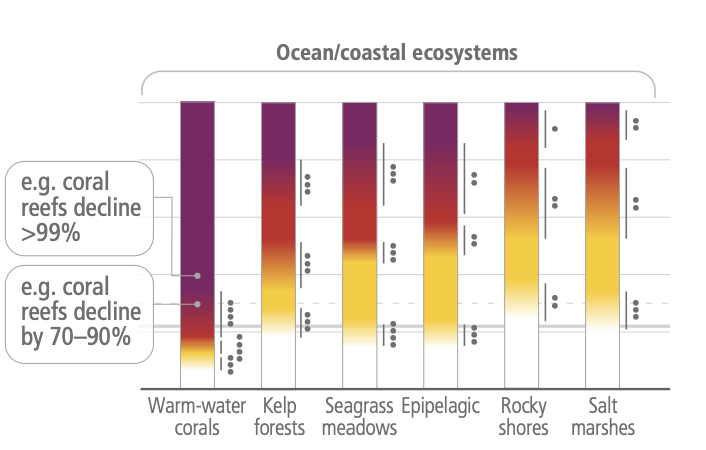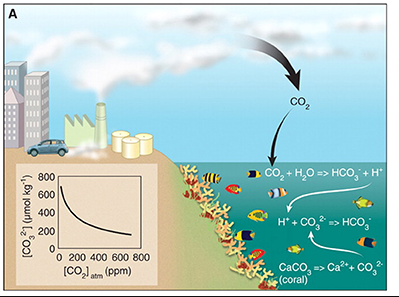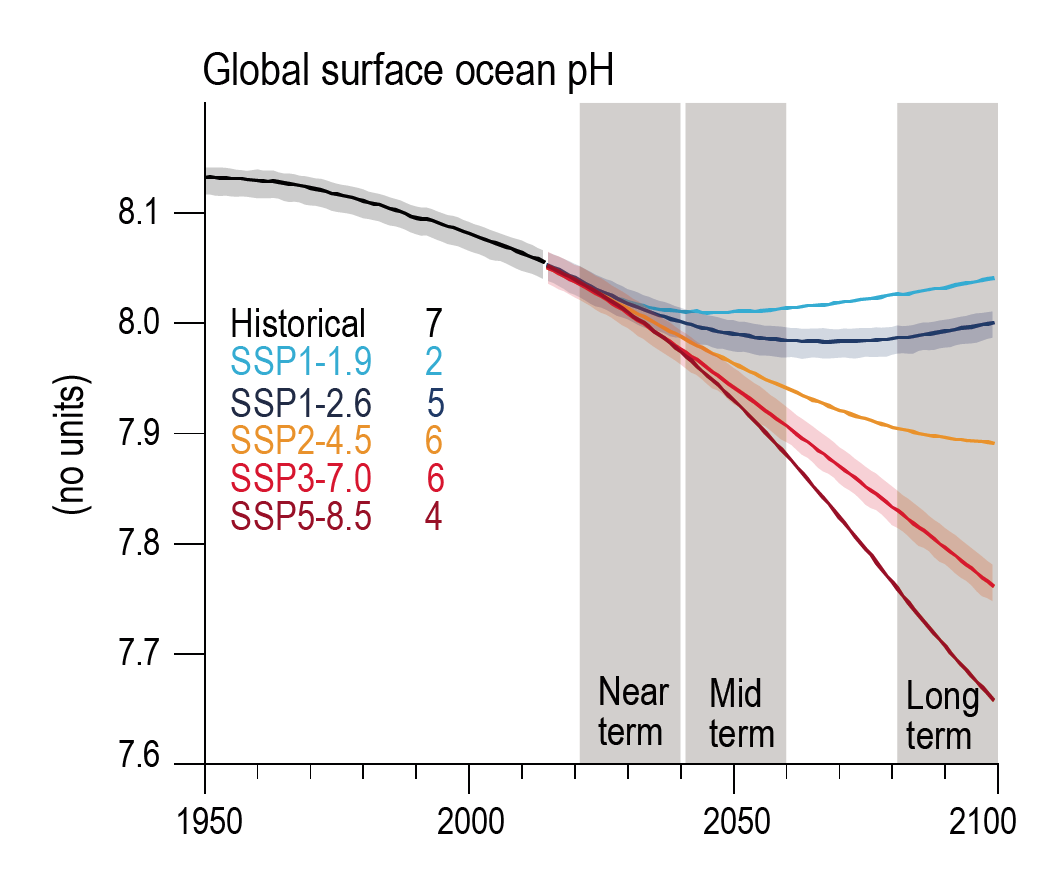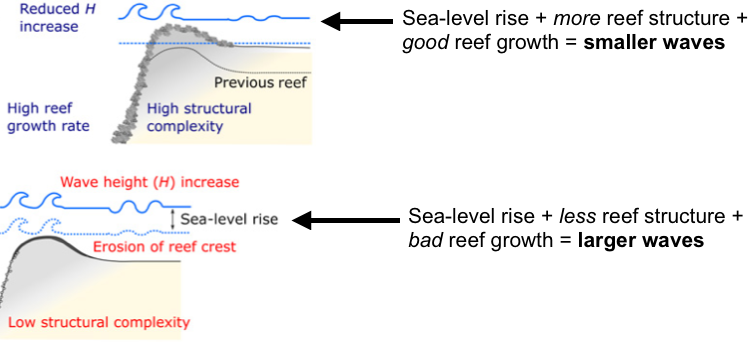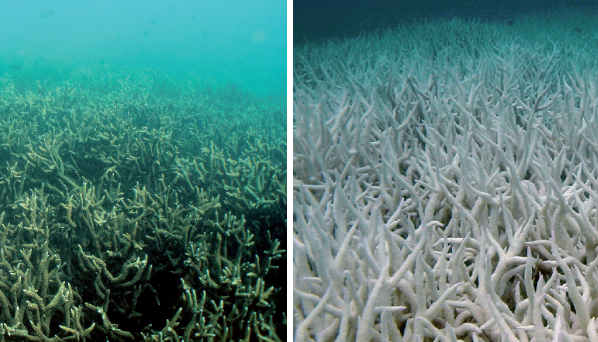
Coral reefs and their ecosystems serve important roles on Earth – they flourish with biodiversity, providing habitat to 25% of known marine species[1,2], and offer coastal protection from storm surges and cyclones[1]. However, coral reefs are also one of the most sensitive marine ecosystems on Earth, and more than half of the world’s coral reefs are under medium to high risk of degradation[3]. As global warming further deteriorates coral reefs, marine species will not be the only ones affected. Humans also depend on coral reefs, which offer an economic value of roughly $375 billion dollars in goods and services annually[1].
Scientists have already observed coral reefs deteriorating due to climate change[1,3], but what do they expect in the future? Can coral reefs recover from the effects of climate change, and if so, will they face greater challenges ahead? In this insight article, we will present evidence collected by scientists around the world on the effects of climate change and anthropogenic (i.e., human) impacts on coral reefs.
Main Takeaways:
- Coral reefs are one of the most sensitive ecosystems on Earth and greatly benefit humans and thousands of oceanic species
- Human greenhouse gas emissions are warming the oceans, driving bleaching – and sometimes death – of coral reefs
- Carbon dioxide (CO2) emissions are increasing ocean acidification which breaks down coral reef skeletons and inhibits their growth
- Climate change has increased global sea levels and storms (in some regions); these changes often worsen the impacts of other climate effects on coral (e.g., acidification)
- Ongoing greenhouse gas emissions – especially CO2 – and the resulting global temperature increases will worsen the effects above; decreasing our emissions will help mitigate them
Coral reefs are entire ecosystems that are highly sensitive to changing conditions
Coral reefs typically grow in shallow regions of Earth’s oceans and are built from a skeleton of calcium carbonate (CaCO3) secreted by reef-building corals (e.g., coral polyps) and macroalgae[3] (Figure 1). The primary parts of a coral reef are its skeleton and coral polyps; however, its broader ecosystem also includes thousands of fish and other species that use the reef as protection and a food source[1].
Figure 1 – The larger figure shows the diverse species and habitat of a coral reef ecosystem (i.e., coral reef and the species that use it for shelter and food). The smaller inset figure shows the anatomy of a coral polyp – the small, colorful animals that together make up coral colonies on reefs. Source: National Oceanic and Atmospheric Administration (NOAA)
However, given the composition, structure, and environment of coral reefs, they are sensitive to changing conditions[1] (Figure 2). Although both climatic and non-climatic drivers can negatively affect corals, the Intergovernmental Panel on Climate Change (IPCC) explains that climate change impacts (e.g., ocean warming, acidification, sea level rise etc.) will worsen the impacts of non-climatic anthropogenic drivers[4]. Examples of non-climatic anthropogenic drivers include pollution, overfishing, and physical destruction of reefs[1].
Figure 2 – Effects of climate change on Earth’s oceans and coral reef ecosystems. Increased human greenhouse gas emissions (top of figure) drive climate changes which impact Earth’s oceans (middle of figure) and negatively affect coral reefs (bottom of figure). Source: NOAA
Researchers – including Dr. Hoegh-Guldberg, Professor and Director, Global Change Institute, University of Queensland – explain that the impacts of climate change on coral reefs have already been observed and will continue with rising greenhouse gas emissions:
“we are already seeing major and fundamental change occurring in the world’s ocean in response to climate change and that the rate of change is largely outstripping the ability for coral reefs to adapt genetically or relocate. If greenhouse gas emissions are not mitigated, it is very clear that the ocean will be a vastly different place by the mid to late century”[1].
But why is coral reef health important? Dr. Katrin Meissner, Professor at the University of New South Wales, provided Science Feedback with a comment that highlights the some of the main reasons:
“Coral reefs provide food, income and coastal protection from storms and floods for hundreds of millions of people. Even though they cover less than 1% of the seafloor, they support at least a quarter of all marine species. Coral reefs are not only vital for ocean health, but they also provide billions of dollars in economic value through food, tourism, food, tourism, pharmaceuticals and coastal protection.”
In the sections to follow, we will outline some of the biggest impacts of climate change on coral reefs thus far, and what is anticipated in the future.
Rising temperatures are triggering bleaching – and sometimes death – of coral reefs
Coral reefs are especially sensitive to temperature changes, which can trigger a phenomenon called ‘bleaching’[3] (Figure 3). Bleaching occurs when corals experience a breakdown and loss of algae which normally lives inside their tissue and provides them with energy. As they dispel these symbiotic algae, they lose their color. As the IPCC explains, “mass coral bleaching and mortality, triggered by positive temperature anomalies (high confidence), is the most widespread and conspicuous impact of climate change”[3]. When bleaching occurs, corals become more susceptible to death and disease[1].
Bleaching events have greatly increased since the early 1980s; for example, “from 2016 through 2020, the Great Barrier Reef experienced mass coral bleaching three times in 5 years”[4]. There have also been major losses of coral; there has been at least a 50% decrease of warm-water coral reefs over the last 30 to 50 years in many of the world’s tropical regions[1].
Figure 3 – The same coral community in Halfway Island, Great Barrier Reef, before and after a bleaching event in 2002, where approximately 95% of the coral community was “severely bleached”. Source: IPCC (2014)[3]
Although coral bleaching at local scales has been reported for over 100 years, there is evidence that the widespread bleaching events affecting larger regions since the 1980s is novel and driven by rising ocean temperatures. As explained in Guldberg et al. (2017), “there is a high level of confidence that the increases in mass coral bleaching and mortality since the early 1980s are due to anthropogenic climate change in particular ocean warming”[1].
Human greenhouse gas emissions have increased global temperatures in recent times, worsening heat waves on land[5] – a topic that Science Feedback has covered in past articles (example linked here). However, heat waves can also occur in the ocean[4]. These are referred to as marine heat waves, and they have increased in frequency and duration due to human-induced climate change[5]. With the changes that have already been observed as a result of ocean warming, what can we expect in the future?
The IPCC explains that:
“coral reefs are at risk of widespread decline, loss of structural integrity and transitioning to net erosion by mid-century due to the increasing intensity and frequency of marine heatwaves […] In response to heatwaves, bleaching of the Great Barrier Reef is projected to occur annually if warming increases above 2.0°C, resulting in widespread decline and loss of structural integrity”[4]
They also explain that even if warming is kept to under 2.0°C, all corals will degrade from their current state[6]. Different scenarios of global warming – largely dependent on human greenhouse gas emissions[4] – and their consequences to warm-water coral reefs and other ocean/coastal ecosystems are shown in Figure 4 below.
Figure 4 – Global risks to select ocean/coastal ecosystems for different future global surface temperature warming scenarios (1-5°C of warming, as shown on the right vertical axis). The color spectrum represents risk/impact increasing from white (undetectable) to purple (very high). Note that each ecosystem reacts differently to increasing global surface temperatures, with coral reefs facing impacts sooner than others. For coral reefs, examples of risks/impacts are a 70-90% decline at 1.5°C of warming, and greater than 99% decline at 2°C of warming. Adapted from the following source: IPCC (2023)[7]
Although coral reef recovery can occur – a point that is sometimes used to misrepresent the impact of climate change on coral reefs – they do not always make a ‘full recovery’ back to normal. This was explained to us in a comment from Dr. John Bruno, Distinguished Professor in the Department of Biology at The University of North Carolina at Chapel Hill:
“One important caveat is that most (but not all) coral reefs can and do recover even from devastating bleaching. It can take as little as 8-10 years but often takes decades. However, “recovery” in terms of the amount of living coral cover doesn’t always mean a return to the pre-die off condition. That’s because the corals that were killed off get replaced by fast growing, weedy species. Like the weeds that quickly sprout up after a forest is burned or clear cut.”
However, despite widely-available scientific evidence, misinformation about coral health and recovery still spreads. Science Feedback has covered several claims in the past. For example, The Daily Wire published an article on 24 October, 2021 which claimed that a report from the Australian government found the Great Barrier Reef is “growing quickly”. However, as explained in our past review (linked here), these claims are misleading and lack context about coral reef recovery. In that review, Professor Terry Hughes, former director of the ARC Centre of Excellence for Coral Reef Studies, explained the following in a comment to Science Feedback:
“The reefs are not growing or shrinking – that’s a geological process that occurs over centuries or more,” he said. “Growth rates of individual corals is not a conventional way to assess the condition of reefs.”
Human CO2 emissions are damaging coral reefs through increased ocean acidification
Along with ocean warming, ocean acidification has some of the most negative impacts on coral reef health. Coral reefs are sensitive to pH levels (i.e., acidity) and carbonate chemistry in ocean water[1,3,7]. Scientific studies show that the oceans are acidifying due to anthropogenic carbon dioxide (CO2) emissions[1,3,7]. This occurs because CO2 is not only stored in Earth’s atmosphere, but also gets absorbed into oceans where it reacts with water to produce hydrogen ions. These ions increase the oceans acidity and also bond to another molecule (carbonate), therefore making less of it available to corals to build their skeleton with (Figure 5).
Figure 5 – Simplified diagram showing how human CO2 emissions in Earth’s atmosphere enter the oceans and interact with water to increase acidity and lessen the availability of one molecule (carbonate) corals use to build their skeletons (calcium carbonate). It is worth noting that roughly 30% of human CO2 emissions have been absorbed by Earth’s oceans[6,8]. Source: Hoegh-Guldberg et al. (2017)[1]
The IPCC explains that ocean acidification reduces biodiversity and the rate of coral calcification, while also speeding up the dissolution (i.e., breakdown) of coral skeletons[3].
Compared to the past, scientists have found that “the current rate of ocean acidification is unprecedented within the last 65 Ma [million years] (high confidence), if not the last 300 Ma [million years]”[9]. NOAA explains that since the beginning of the industrial revolution, ocean acidity has gone up approximately 30%.
While some species may be able to adapt to these types of changes, scientists explain:
“evidence that coral reefs can adapt at rates which are sufficient for them to keep up with rapid ocean warming and acidification is minimal, especially given that corals are long-lived and hence have slow rates of evolution”[1]
Unfortunately, these changes are expected to continue with CO2 emissions, as the IPCC explains: “further increases in atmospheric CO2 are virtually certain to further acidify the Ocean and change its carbonate chemistry”[9]. Note in Figure 6 that different climate change/emission pathways (projections) – labeled as ‘SSP’ – show different ocean pH (acidity) levels, highlighting the significance of human CO2 emissions and climate responses on future ocean acidification.
Figure 6 – Projected global surface ocean pH based on different ‘Shared Socioeconomic Pathways (SSPs)’ – i.e., climate change scenarios based on both emissions and climate change response – from present to 2100. Note that a drop in pH is an increase in acidity (i.e., low pH is acidic, high pH is basic). Source: IPCC (2021)[4]
Sea-level rise and intense storms negatively impact coral reefs; both are expected to worsen over the next century due to climate change
Ocean acidification and ocean warming are the main, and more direct, climate-related drivers of coral reef degradation. However, other consequences of climate change – such as sea-level rise and intense storms – can impact coral reefs through cumulative effects. For example, as explained in Hoegh-Guldberg et al. (2017):
“The combination of higher sea levels and more intense storm systems is likely to increase the amount of force exerted by wave action on coastal areas, which has implications for coastal infrastructure, as well as the state of ecosystems such as coral reefs”[1].
Certain climate change effects on coral reefs can worsen the effects of others. For example, the IPCC explains that coral reefs ability to withstand wave impacts – i.e., force exerted by waves – can be lessened by coral reef degradation (e.g., through ocean acidification):
“Recent literature also shows that alterations of coral reef 3D structure from changes in growth, breakage, disease or acidification can profoundly affect their ability to buffer waves impacts (through wave breaking and wave energy damping), and therefore keep-up with SLR”[6] (Figure 7).
Figure 7 – Conceptual diagram showing differences in wave height between a coral reef with a high growth rate/structural complexity (i.e., not degraded) (top illustration) and a coral reef that has been eroded and has low structural complexity (i.e., degraded) (bottom illustration). Note that the wave height increases more with sea-level rise in areas with eroded coral reefs, which exposes coastal communities to increased waves, erosion, and flooding[10]. Adapted from the following source: Harris et al. (2018)[11]
These findings clearly show that the negative impacts of climate change on coral reefs do not occur in isolation – but that some effects can worsen the impacts of others. In the examples above, the effects of ocean acidification, sea-level rise, and storm intensity – expected to worsen with climate change to varying degrees[4] – can work together to amplify coral reef degradation. We discussed the evidence of acidification, but what about storms and sea-level rise?
The link between sea-level rise and climate change is clearly shown by scientific evidence[4,6] – something we covered in a past insight article linked here. For that article, we asked Dr. Peter Gleick, President-emeritus and Senior Fellow at the Pacific Institute, about current sea-level rise and its impacts, to which he responded: “Scientific evidence is extremely clear: sea levels have gone up substantially over the past century, as a result of human-caused climate change, and the rates of increase are accelerating.” (Figure 8).
Figure 8 – Global average absolute sea-level change (in inches) from 1880-2021, based on tidal gauge measurements (orange line) and recent satellite measurements (blue line). Note that ‘absolute’ sea-level change is used to represent the ocean’s surface, without regard to changes in nearby land elevation. Figure source: United States Environmental Protection Agency (EPA) with data from NOAA and CSIRO
Prior recent increases, sea levels were relatively stable for a long stretch of time (i.e., nearly 3000 years)[12,13]. Looking to the future, models show that rates of sea-level rise will depend on our trajectory of greenhouse gas emissions[4,6] – higher emissions means higher levels of sea-level rise[4,6], and thus a greater likelihood of impacts to coral reefs. And what about storms?
Although scientists understand many of the impacts of storms on coral reefs, the evidence about recent changes in storm intensity and frequency are a bit more complex – something we addressed in an article linked here. Despite the complexity of studying storms, studies have still found evidence of changes. For example, the IPCC explains that “it is likely that the proportion of intense tropical cyclones has increased over the last four decades and that this cannot be explained entirely by natural variability”[14]. They also explain that the proportion of intense tropical cyclones is expected to increase, although the frequency of total cyclones will probably remain the same or decrease[14].
What can be done to limit degradation of coral reefs?
As with many climate issues, when scientists and policy makers discuss solutions, there are two main approaches: mitigation or adaptation. Adaptation involves adjusting to current and future changes, while mitigation aims to reduce changes. For coral reef degradation, examples of adaptation measures include things like coral reef restoration[4]. Whereas, mitigation involves reducing greenhouse gas emissions, which scientific evidence has unequivocally shown to be increasing global temperatures and ocean temperatures[4], in turn affecting coral reefs as outlined in previous sections.
A combination of adaptation and mitigation is prudent for many issues – and even widely recommended by experts for issues such as sea-level rise, as we covered in an article linked here. However, the IPCC explains that adaptation measures which have been tested (e.g., coral reef restoration) would be “jeopardized” given how near-term many climate risks are[4]. And those that could theoretically work, will not work at the scale of an entire reef[4].
The latter point is well-summarized in Hoegh-Guldberg et al. (2017):
“It is also clear that there are few or no adaptation strategies for humans to counter the risks of ocean warming and acidification at global scales. If they did exist, they would almost certainly be prohibitively expensive relative to the costs of developing solutions to the unprecedented rise of CO2 in the earth’s atmosphere.”[1]
Therefore, as these experts explain, there are two clear options for preserving coral reefs:
“The first is to stabilize planetary temperature and CO2 concentrations as quickly as possible. Only then will biological responses such as acclimation and genetic adaptation have any chance of operating. The second is to dramatically reduce local stresses which are currently acting on coral reefs and which are reducing their resilience to climate change.”[1]
On a more optimistic note, they conclude that:
“if we do these two things, there is a chance that conditions will stabilize on planet earth by mid-to-late century, ensuring that some of the spectacular coral reef ecosystems will be able to flourish across the world’s tropical regions”[1].
Conclusion
Coral reefs are highly sensitive marine ecosystems that are relied on by thousands of species, and which greatly benefit humans around the world. Climate change and other anthropogenic impacts are driving deterioration of coral reefs – mainly through bleaching and ocean acidification – which exacerbate effects from local stresses, such as pollution and overfishing. The primary driver of climate change is greenhouse gas emissions – mainly CO2 – which is projected to further increase ocean warming, sea-level rise, storm intensity, and ocean acidification. All of which negatively affect coral reef health.
Coral reef vulnerability to climate change, and scientist’s recommended actions are succinctly summarized in this quote from the IPCC:
“The very high vulnerability of coral reefs to warming, ocean acidification, increasing storm intensity and SLR [sea-level rise] under climate change, including enhanced bioerosion (high confidence), points to the importance of considering both mitigation and adaptation.”[4]
SCIENTISTS’ FEEDBACK
To gain deeper insights on the impacts of climate change on coral reefs, we asked climate science experts the following questions and included their responses below:
- Is there evidence that climate change has already impacted coral reefs? If so, what are some of the main effects scientists have observed?
- What changes or impacts will coral reefs likely face as a result of climate change over this century?
- Do changes to coral reefs negatively affect humans and society? Have these effects already been observed?
Is there evidence that climate change has already impacted coral reefs? If so, what are some of the main effects scientists have observed?
John Bruno, Professor, The University of North Carolina at Chapel Hill:“There is extensive and clear evidence that climate change has already greatly impacted coral reefs. The evidence comes in three broad categories.
- Hundreds of published field studies of how acute warming, lasting weeks to months (i.e., marine heatwaves*), affects coral populations and communities. These studies are based on field monitoring of coral community composition and cover, typically for many years. This enables the quantification of how a heatwave affected the reef and subsequently whether/how quickly coral populations recovered from it. Ideally, these field studies also have data on temperature at the study sites and other factors that could potentially affect coral population dynamics. For example, Aronson et al. (2002)[15] documented the mass-bleaching and subsequent mass coral mortality that was part of the first global event in 1998. These studies are observational, but are still incredibly important. Scientists can now predict with incredible precision when and where coral mortality will occur based only on sea surface temperature measurements made with satellites. That’s because we’ve ground-truthed these predictions hundreds of times in the field. We watch the ocean warm over days or weeks, then see the corals turn white, and eventually die. There’s no question what the causal factor is. It’s just like observing a wildfire destroy a forest. It’s actually not rocket science. But it is very time consuming and requires hundreds of independent teams of scientists monitoring thousands of reefs over decades. *Marine heat waves are short term extremes from normal temperature conditions and are caused by longer-term anthropogenic warming. They are becoming more frequent and extreme because of the warming trend (not due to an increase in ocean temperature variability)[16].
- Regional to global-scale synthetic studies (essentially meta-analyses) that combine tens of thousands of quantitative reef surveys (in which scientists or trainer volunteers measure coral community composition) that document the gradual loss of living coral cover over the last ~40 years. Roughly a dozen or so of these studies have been published. For example, Tebbett et al. (2023)[17] and Eddy et al. (2021)[18]. The main insights from these studies are: A) Coral cover is very dynamic and variable among regions, B) In most regions coral cover is declining at ~1% per year, C) The multi-decade decline in cover is inversely related and can mostly be attributed to warming. This means that coral cover has declined as the ocean has warmed. Although some argue that local factors (mainly fishing and pollution) are also, equally, or even more important in coral decline (than warming), the scientific evidence does not support that hypothesis. For example, there is no relationship between living coral cover and local human influence – that is; extremely isolated reefs and reefs inside marine reserves are equally affected by warming and are no better off than unprotected reefs and reefs adjacent to human population centers [Bruno and Valdivia (2016)[19], Bruno et al. (2018)[20]]. This lesson became especially clear in 2016 and 2017 when many of the world’s most isolated, pristine, and best-protected reefs bleached and saw mass coral mortality, e.g., the northern Great Barrier Reef and the Chagos Archipelago.
- Mechanistic experimental studies that have identified the specific mechanisms through which temperatures only a degree or two above what’s normally experienced cause corals to bleach and die. These studies are performed in aquaria or laboratories, where corals can be experimentally exposed to higher than normal temperatures. Overall this evidence strongly supports the hypothesis that ocean warming has already transformed tropical coral communities globally. Importantly, all three types of evidence support this conclusion. One important caveat is that most (but not all) coral reefs can and do recover even from devastating bleaching. It can take as little as 8-10 years but often takes decades. However, “recovery” in terms of the amount of living coral cover doesn’t always mean a return to the pre-die off condition. That’s because the corals that were killed off get replaced by fast growing, weedy species. Like the weeds that quickly sprout up after a forest is burned or clear cut. More importantly, the problem is that the time between heatwaves and mass coral die offs is getting shorter and shorter. It used to be about 10-15 years. Then it was 6-8 years. Now, some reefs are experiencing heatwaves every year. Soon, that will be true on most if not not all reefs. That means there won’t be nearly enough time for recovery after die-offs. Moreover, the extreme temps during these heatwaves as well as the background temperatures keep growing. All of that means the future outlook for corals and reefs isn’t great. Given their role as the habitat-forming or foundation species in this system, nearly all of the research focus has been on corals. It is also much easier to measure the effects of heatwaves in coral community dynamics than it would be for smaller animals hidden within the reef. One exception is reef fishes; there is also strong evidence they are affected, both indirectly by the loss of coral (i.e., via habitat degradation) and directly by warming. But hundreds of thousands of other reef organisms that live and depend on coral reefs are also presumably being affected. Exactly how is a frontier in coral reef science.”
What changes or impacts will coral reefs likely face as a result of climate change over this century?
John Bruno, Professor, The University of North Carolina at Chapel Hill:“The degree to which anthropogenic warming impacts reefs later this century depends entirely on how much more the ocean warms. And that’s going to be determined by how much more greenhouse gasses we emit – which is unknowable.
If we reach net zero emissions mid-century, we could still see another ~1ºC of reef warming between now and 2100 (so far reefs have warmed by about ~1ºC). In that case we’d almost certainly lose a lot more coral and reef-associated organisms; however, reefs would “survive”, albeit in a highly altered state compared to when I was a kid in the 1970s. On the other hand, if emissions continue to increase and don’t begin to decline until late this century, or if Dr. James Hansen is right about the acceleration of warming [see link here], then in that case it’s hard to imagine reefs remaining except for a few highly thermally resilient and weedy species, probably of seaweeds and microbes [i.e., those colonizing the skeletons of dead corals].”
Is there evidence that climate change has already impacted coral reefs? If so, what are some of the main effects scientists have observed?
Katrin Meissner, Professor, University of New South Wales:“Yes, of course, there is plenty of evidence. Climate change warms the surface waters of the oceans, which increases the frequency and intensity of marine heat waves. When corals are exposed to warmer water temperatures than they are used to, they expel their endosymbiotic algae, which provide food for the corals. Consequently, the corals bleach (the algae are giving the colours to the corals) and starve. If these bleaching events last for too long, the coral dies. Coral reefs can recover to a certain extent, but they need time to do so. Marine heatwaves are now coming faster, leaving less time for recovery, and are also more widespread. We have seen an increase in these bleaching events in recent years. A report from 2020 found that the world has lost approximately 14% of corals between 2009 and 2018. This year, we witnessed the fourth global bleaching event, the first occurred in 1998.
Another way climate change is affecting coral reefs is by changing the ocean water’s chemistry. With higher CO2 concentrations in the atmosphere, the surface ocean waters also absorb more carbon. This leads to an increase in hydrogen ions (and a decrease in pH, i.e. acidification) and at the same time a decrease in carbonate ions. The skeletons of corals are made from calcium carbonate. With less carbonate in surface waters, the skeletons are less stable and more prone to dissolve.”
What changes or impacts will coral reefs likely face as a result of climate change over this century?
Katrin Meissner, Professor, University of New South Wales:“Projections of habitat conditions for coral reefs look dire. We know that the frequency and magnitude of marine heat waves will increase in the future, even if we follow the most optimistic future scenario for future fossil carbon emissions. The climate system is slow, and it is still adjusting to present day CO2 concentrations. That means that even if we succeed in stabilising CO2 concentrations, which can only happen if we reach globally net zero emissions, the climate will continue to warm before temperatures stabilize, and this new climate will be hotter than the climate our coral reefs evolved in. It is projected that by mid century 98% of the world’s coral reefs will be facing bleaching events that are so frequent that a recovery is impossible[21]. Coral reefs are therefore the canary in the coal mine for detecting climate change impacts on ecosystems, they will be the first to go.”
Do changes to coral reefs negatively affect humans and society? Have these effects already been observed?
Katrin Meissner, Professor, University of New South Wales:“Coral reefs provide food, income and coastal protection from storms and floods for hundreds of millions of people. Even though they cover less than 1% of the seafloor, they support at least a quarter of all marine species. Coral reefs are not only vital for ocean health, but they also provide billions of dollars in economic value through food, tourism, food, tourism, pharmaceuticals and coastal protection.”
REFERENCES
1 – Hoegh-Guldberg et al. (2017) Coral Reef Ecosystems under Climate Change and Ocean Acidification. Frontiers in Marine Science.
2 – Fisher et al. (2015) Species richness on coral reefs and the pursuit of convergent global estimates. Current Biology.
3 – IPCC (2014) Cross-chapter box on coral reefs. In: Climate Change 2014: Impacts, Adaptation, and Vulnerability. Part A: Global and Sectoral Aspects. Contribution of Working Group II to the Fifth Assessment Report of the Intergovernmental Panel on Climate Change.
4 – IPCC (2021) Sixth Assessment Report.
5 – Richaud et al. (2024) Drivers of Marine Heatwaves in the Arctic Ocean. Journal of Geophysical Research: Oceans.
6 – IPCC (2019) Special Report on the Ocean and Cryosphere in a Changing Climate.
7 – IPCC (2023) Climate Change 2023: Synthesis Report.
8 – IPCC (2013) Climate change 2013: the physical science basis, in: Contribution of Working Group I to the Fifth Assessment Report of the Intergovernmental Panel on Climate Change
9 – IPCC (2014) 2014: The Ocean. In: Climate Change 2014: Impacts, Adaptation, and Vulnerability. Part B: Regional Aspects. Contribution of Working Group II to the Fifth Assessment Report of the Intergovernmental Panel on Climate Change
10 – Carlot et al. (2023) Coral reef structural complexity loss exposes coastlines to waves. Scientific Reports.
11 – Harris et al. (2018) Coral reef structural complexity provides important coastal protection from waves under rising sea levels. Science Advances.
12 – Clark et al. (2016) Consequences of twenty-first century policy for multi-millennial climate and sea-level change. Nature Climate Change.
13 – Kopp et al. (2016) Temperature-driven global sea-level variability in the Common Era. Proceedings of the National Academy of Sciences.
14 – IPCC (2021) 2021: Technical Summary. In Climate Change 2021: The Physical Science Basis. Contribution of Working Group I to the Sixth Assessment Report of the Intergovernmental Panel on Climate Change
15 – Aronson et al. (2002) The 1998 bleaching event and its aftermath on a coral reef in Belize. Marine Biology.
16 – Oliver et al. (2018) Longer and more frequent marine heatwaves over the past century. Nature Communications.
17 – Tebbett et al. (2023) Benthic composition changes on coral reefs at global scales. Nature Ecology & Evolution.
18 – Eddy et al. (2021) Global decline in capacity of coral reefs to provide ecosystem services. One Earth.
19 – Bruno and Valdivia (2016) Coral reef degradation is not correlated with local human population density. Scientific Reports.
20 – Bruno et al. (2018) Climate Change, Coral Loss, and the Curious Case of the Parrotfish Paradigm: Why Don’t Marine Protected Areas Improve Reef Resilience?. Annual Review of Marine Science.
21 – Meissner et al. (2012) Large-scale stress factors affecting coral reefs: open ocean sea surface temperature and surface seawater aragonite saturation over the next 400 years. Coral Reefs.

